Dry ice is a hazardous material and is regulated in transportation. Specific procedures are necessary for the safe handling and shipping of materials refrigerated with dry ice. Hazmat University offers a full line of online training for hazmat also known as dangerous goods. The training is applicable for hazmat employees, shippers and freight forwarders that perform functions involving the hazardous material or dangerous goods regulations. Knowing how to use the regulations is crucial for any hazmat employee performing any function related to the preparation of hazmat shipments, including dry ice.
What is Dry Ice?
Dry ice is the solid form of carbon dioxide. There are many uses for dry ice. In shipping, it is used to keep items cold. The main advantage to dry ice is that it keeps products cold without creating water. Dry ice goes through a process known as sublimation. Sublimation happens when a material changes from a solid state directly to a gas. In the case of dry ice, the gas is carbon dioxide.
In transportation, dry ice poses several hazards. The dry ice itself is so cold, it can burn skin. Improperly vented packages may rupture from the buildup of gases. Too much carbon dioxide in a transport container or airline cargo hold can create an environment depleted of oxygen, causing a hazard to anyone entering the area.
Is Shipping Dry Ice Regulated in Transportation?
The short answer to this question is yes, dry ice is regulated in transportation. Dry ice is shipped under the proper shipping name and UN number of Carbon Dioxide, Solid, UN1845. This entry is listed in the dangerous goods lists of all the transportation regulations.
Below, you see the entry for Carbon Dioxide, Solid from the 49 CFR. Notice the A and W in the first column of the table. These symbols mean that the entry is regulated only in the air and vessel mode in the United States. Essentially, dry ice is not regulated by ground transport within the United States while complying with minimum requirements for packing in accordance with 49 CFR 173.217.

But what if you’re shipping in the air or vessel mode? Let’s look at them individually.
Shipping Requirements for Dry Ice by Air
We’ll use the IATA Regulations to review the requirements for shipping dry ice by air. We’ll explore two shipping scenarios, using dry ice with non-dangerous goods and using dry ice with dangerous goods. The examples below do not consider State and Operator variations.
First, dry ice is used to keep non-dangerous goods such as food cold or frozen. The entry in the list of dangerous goods for Carbon Dioxide, Solid is below.

As you can see, we are allowed 200 kg of dry ice in our package whether using passenger or cargo aircraft only. Our packing instruction is 954 and we have 3 special provisions listed.
Carbon dioxide, solid is not required to be shipped in UN packaging. Packaging used to ship dry ice must allow venting of carbon dioxide gas to prevent accumulation of pressure which will lead to package rupture . The outside of the packaging must be marked with the names and addresses of the shipper and consignee, the Class 9 hazard label, proper shipping name and UN number (Carbon Dioxide, Solid, UN1845), and the net weight of dry ice contained in the packaging.
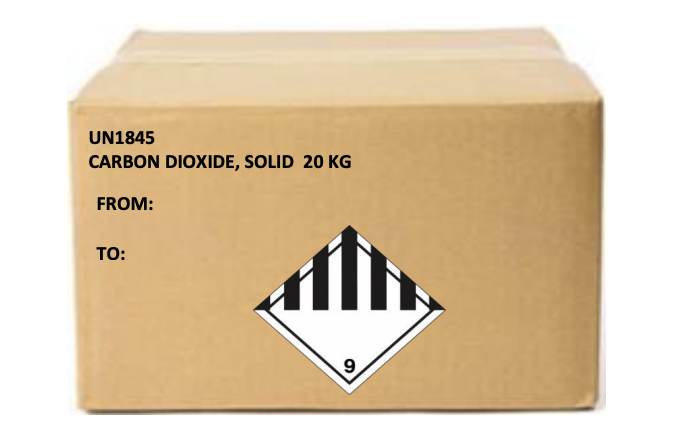
When dry ice is used to cool non-dangerous goods, a Shipper’s Declaration is not required. Instead, a note must be added to the Air Waybill so that the flight crew knows of the presence of the dry ice.

When dry ice is used to cool dangerous goods, there are some additional steps that need to be taken. First, the dangerous goods must be packaged, marked and labeled, and documented as normal. The dry ice may be placed inside the DG packaging or outside the packaging in an overpack. Whichever way the dry ice is packaged, the proper shipping name, UN number (Carbon Dioxide, Solid, UN1845) and net weight of dry ice must be shown on the outside of the packaging. See examples below
Dry ice in the same UN tested package as DG
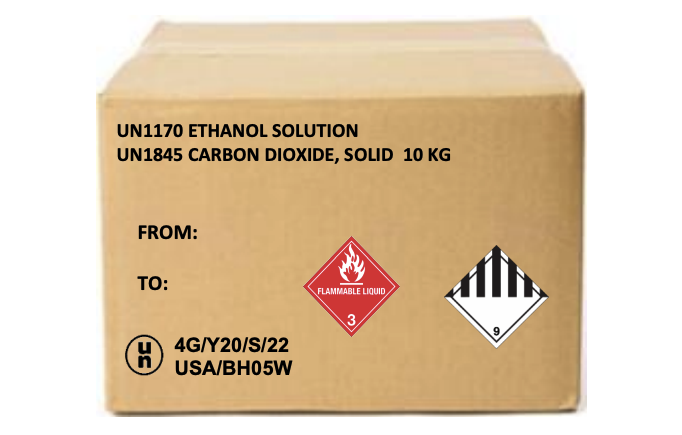
Dry ice in the same overpack with DG
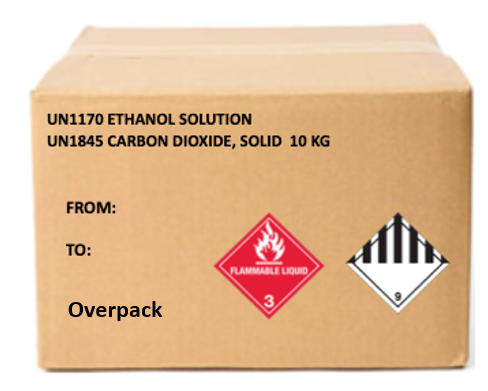
Whenever dry ice is used to cool dangerous goods, a Shipper’s Declaration for Dangerous Goods (DGD) is required.
When the dry ice is packed in the same UN tested packaging as the material, we use the “all packed in one” statement on the DGD. Q-value is not required to be calculated in this case as dry ice is excepted from the Q-value requirement.
Dry ice in the same UN tested package as DG

When dry ice is added to an overpack, the basic description for all of the dangerous goods and the dry ice are entered individually. The overpack used statement is added under the quantity and type of packing.
Dry ice in the same overpack as DG

Shipping Requirements for Dry Ice by Ocean
While shipping dry ice in the vessel mode has several differences from the requirements by the air mode, the packaging requirements are similar. We’ll look at the requirements from the International Maritime Dangerous Goods Code (IMDG Code). Dry ice in the vessel mode is not required to be packaged in UN tested packaging, but it is required to be in strong packaging with adequate venting to prevent accumulation of internal pressure and rupture. The outside of the packaging must be marked with the UN number and proper shipping name and include the class 9 label. The example below shows a package that contains dry ice being used to cool non-dangerous goods.
Dry ice used to cool non-DG
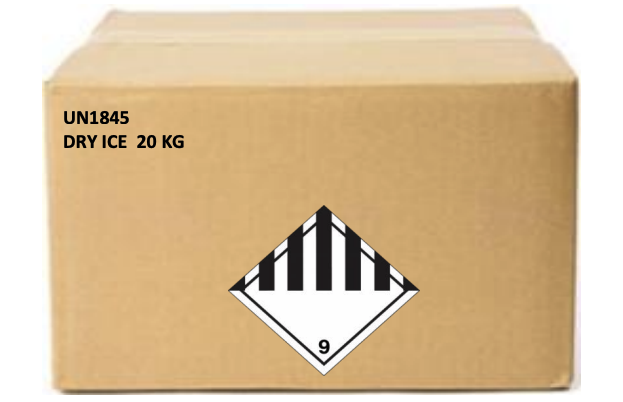
Just as in the air mode, when dry ice is used to cool dangerous goods, the dangerous goods must be packaged, marked and labeled, and documented as normal. The dry ice may be placed inside the DG packaging or outside the packaging in an overpack. Whichever way the dry ice is packaged, the proper shipping name and UN number (Carbon Dioxide, Solid, UN1845 or Dry Ice UN1845) of dry ice must be shown on the outside of the packaging. The net weight of dry ice in the package is not required to be displayed on the outside of the package. See examples below.
Dry ice in the same package as DG
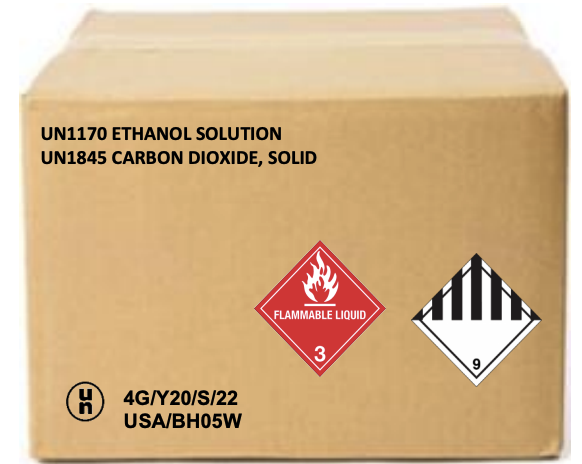
Dry ice in the same overpack as DG
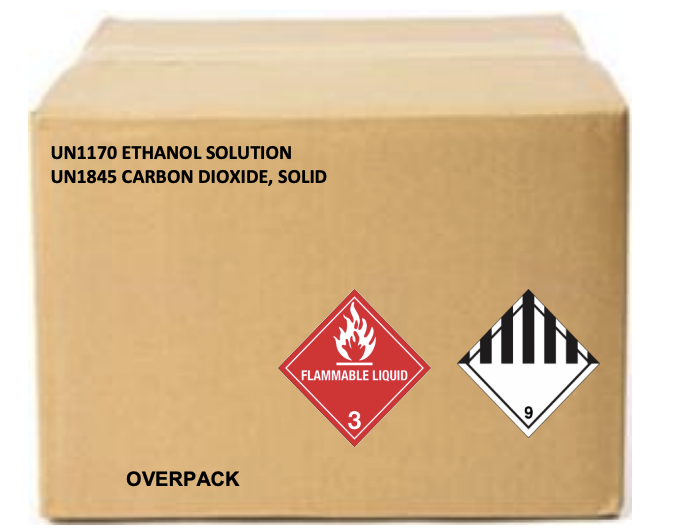
The documentation requirements in the IMDG Code have some notable differences from the IATA regulation. First, documentation is always required to accompany a shipment that has dry ice in it. This includes situations where the dry ice is cooling non-dangerous goods. The full documentation requirements are in place including the need for the full name and address of the shipper and consignee, the basic description of the dry ice and the total quantity of dangerous goods. See below for example documents that correspond to the example packages above.
Dry ice used to cool non-DG

Dry ice in the same package as dangerous goods

Dry ice in an overpack with dangerous goods

It’s important to note that in the IMDG Code, Carbon Dioxide, Solid and Dry Ice are proper shipping names.
Marking and Placarding CTU
Cargo transport units (CTU) are required to display a placard for each hazard class loaded within the container. When loading shipments that include dry ice, it is important to make sure the Class 9 placard is displayed on the outside of the freight container; one placard on each end and one on each side.
An asphyxiant marking must be added to the outside of the CTU that has been loaded with dry ice that was used as a coolant. The marking (shown below) must include the proper shipping name and be placed on all access points to the unit in a way that is visible to anyone entering it.
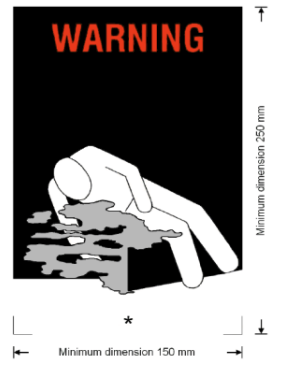
The above summarizes the requirements for shipping dry ice. Please refer to the regulations to be 100% when shipping your dry ice, whether it accompanies a non-DG or DG.
Order Your Online Hazmat Training Courses from Hazmat University Today
Shipments containing dry ice may pose a number of potential hazards during transport. For this reason, dry ice is regulated as a “hazardous material” or “dangerous good” by International and Federal Regulations. If you require initial or recurrent hazmat training, Hazmat University provides easy-to-learn, self-paced online hazmat courses.
Whether you are involved in ground, air shipping, or ocean shipping or a combination of these modes of transport, Hazmat University’s online hazmat training programs offer the latest and most effective learning materials. Enroll today and be ready to ensure compliance with the most current regulatory updates. To order Hazmat University’s online hazmat training courses or to talk to our knowledgeable team members, call (844) 427-0167 or reach us online.
Be Confident. Be Competent. Be Compliant.